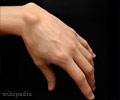African Americans have a higher burden of multiple, large-joint osteoarthritis (OA), says a new research.

OA is the most common type of arthritis and typically affects multiple joints. The National Institute of Arthritis and Musculoskeletal and Skin Diseases (NIAMS) estimates that more than 27 million adults, 25 years of age and older, are burdened by OA. With the percentage of those affected by OA increasing as the population ages, NIAMS projects that 67 million individuals will have doctor-diagnosed arthritis by 2030. While previous studies have investigated radiographic or symptomatic OA patterns using combinations of joint sites, research of multi-joint involvement has mainly been limited to Caucasian women.
For the current study, part of the Johnston County Osteoarthritis Project, Dr. Amanda Nelson from the University of North Carolina at Chapel Hill-UNC Rheumatology/Thurston Arthritis Research Center and colleagues, analyzed radiographic data for the hands, knee (tibofemoral [TFJ] and patellofemoral joints), hips and spine (lumbosacral) in African American and Caucasian men and women who were 45 years of age and older. The team identified 16 mutually exclusive hand OA phenotypes in 2083 participants and 32 whole-body phenotypes in 1419 individuals. Information on age, gender, race and body mass index (BMI) was also collected through questionnaires and clinical examination.
After adjusting for age, gender and BMI, analysis showed that African Americans had significantly less frequent OA in finger tip joints (distal interphalangeal), alone and with other hand joint sites compared to Caucasians. African Americans compared with Caucasians were twice as likely to have knee (TFJ) OA and had 77% greater odds of knee and spine OA together. Frequencies of OA in hand joint sites other than distal interphalangeal joints were comparable between both races.
Study participants had a mean age of more than 65 years, with a mean BMI categorizing them as obese. One third of participants were male and two thirds were Caucasian. Overall 42% of the study subjects had knee OA, 36% had hip OA and 32% OA of the hand. Spine OA was most common, occurring in 62% of participants. "Racial differences in OA phenotypes were more significant than gender disparity," concluded Dr. Nelson. "Our findings suggest a substantial health burden of large-joint OA, particularly hip and spine, among African Americans and further studies that address this concern are warranted."
Advertisement














